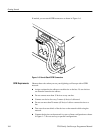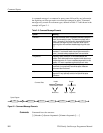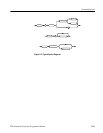
Command Syntax
2–4
TDS Family Oscilloscope Programmer Manual
Clearing the TDS Family Oscilloscope
You can clear the Output Queue and reset the digitizing oscilloscope to accept a
new command or query by using the Device Clear (DCL) GPIB command.
Command Entry
The following rules apply:
H You can enter commands in upper or lower case.
H You can precede any command with white space characters. White space
characters include any combination of the ASCII control characters 00
through 09 and 0B through 20 hexadecimal (0 through 9 and 11 through 32
decimal).
H The digitizing oscilloscope ignores commands consisting of any combina-
tion of white space characters and line feeds.
You can abbreviate many digitizing oscilloscope commands. Each command
listing in the Commands section shows the minimum acceptable abbreviations in
capitals. For example, you can enter the command ACQuire:NUMAvg simply as
ACQ:NUMA or acq:numa.
NOTE. Keep in mind that abbreviation rules change over time as new TDS
models are introduced. Thus, for the most robust code, use the full spelling.
Avoid using the command abbreviations.
If you use the HEADer command to have command headers included as part of
query responses, you can further control whether the returned headers are
abbreviated or are full-length. The VERBose command lets you control this.
You can concatenate any combination of set commands and queries using a
semicolon (;). The digitizing oscilloscope executes concatenated commands in
the order received.
When concatenating commands and queries, you must follow these rules:
1. Separate completely different headers by a semicolon and by the beginning
colon on all commands but the first. For example, the commands TRIGĆ
ger:MODe NORMal and ACQuire:NUMAVg 10 would be concatenated into a
single command:
TRIGger:MODe NORMal;:ACQuire:NUMAVg 10
Abbreviating Commands
Concatenating Commands


















